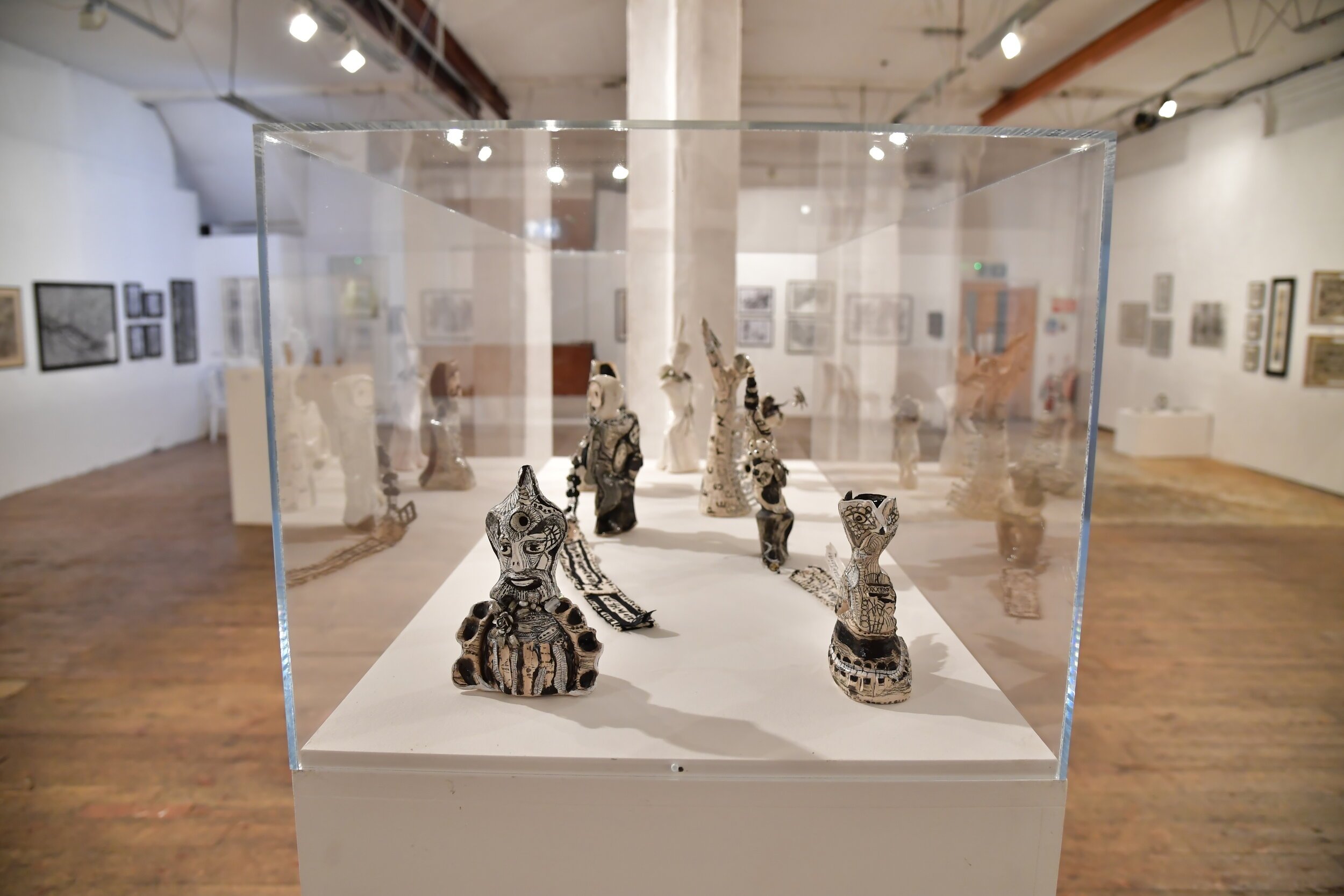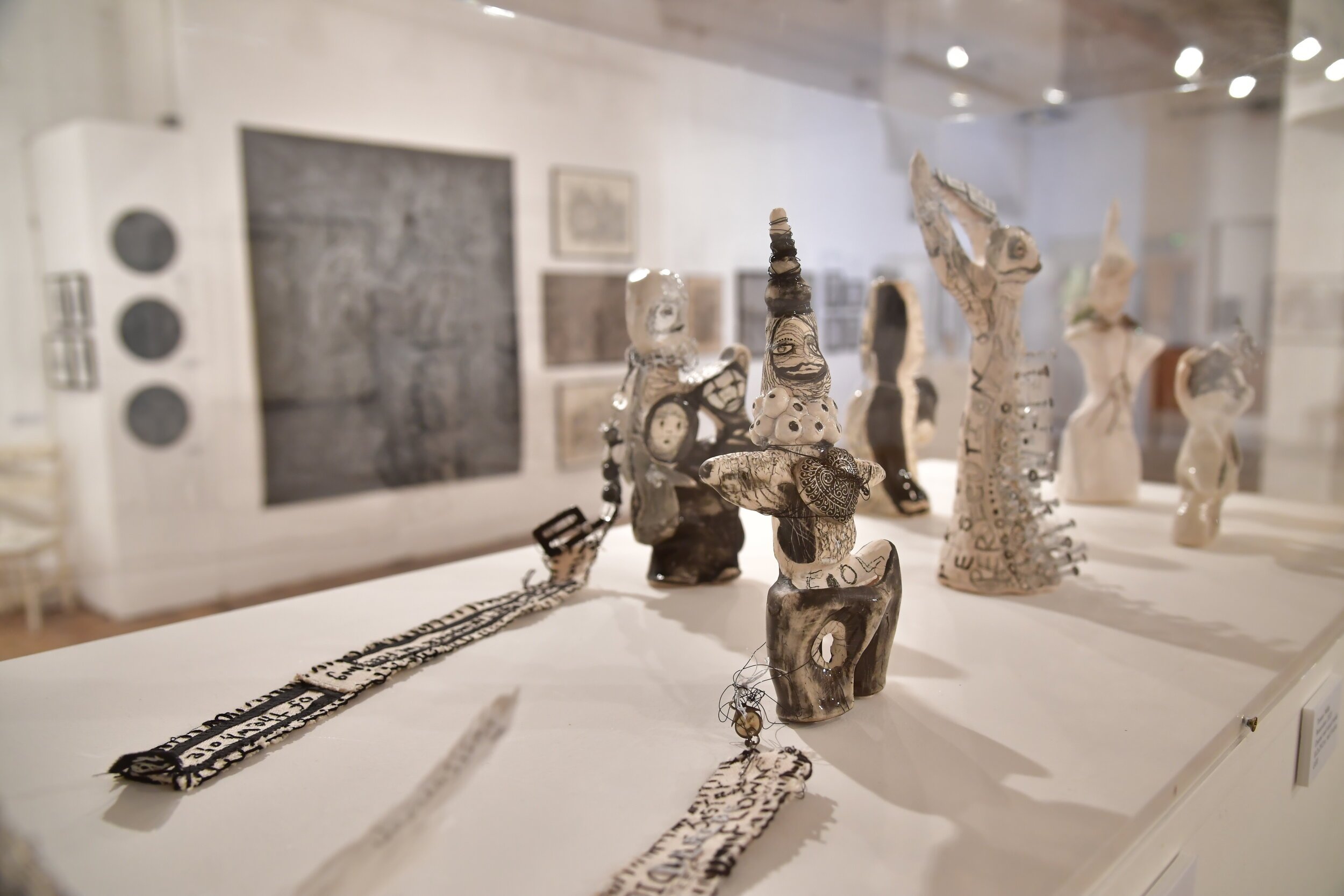IN CONVERSATION - Terence Wilde
For part two of my ‘In Conversation’ series with the artists that I support through my Gallery, I called Terence Wilde for a chat and to check-in. Terence recently featured in my ‘Monochromatic Minds’ pop-up exhibition in London with a new series of black and white ceramic embodiments. As part of this he ran a collage workshop for Headway East London, as well as a ceramic workshop for the public at Hart Club. Read on to hear from Terence about life during lockdown, his involvement in the pop-up exhibition and his art practice more broadly …
Terence Wilde talking at the Monochromatic Minds exhibition.
Photo by Andrew Hood
How do you think your practice has changed because of covid-19?
My work has gone more detailed because I do detailed work when I am anxious. So I seem to have honed in on more detailed work and I am using art as a coping strategy. I have been creating work in particular to be for sale on Instagram, so colour is coming back into things. I am also trying to go back to highly patterned work, as that was part of my training as a textile artist. So I think I am doing things that bring a sense of security back to my practice. My working hours are different now too - I tend to work later at night rather than at the beginning of the day. And due to me not being in work at the moment, I have more of a focus on my own work.
Love and Fear at the Shrine of Mother, 2020
I have taken this question from the talkart podcast that I like listening to… have you learnt any new skills during lockdown?
I wouldn’t say I have learnt any new skills, but I am honing in and developing my existing skills … so I am trying to make my draughtsmanship finer. And this comes from the experience of being in the recent Monochromatic Minds exhibition that Jennifer organised in London. I liked looking at the ones that you looked at with a magnifying glass like Chris Neate and Nick Blinko. I have been inspired by the intimacy and detail in these artist’s works and we went into lockdown straight after that show so they have helped with my thinking. And I guess I have worked on some networking too.
Also I have been looking over my existing body of work and putting everything in order and this has given me clearer direction, as I don’t think things are going to be the same after lockdown. So I am now developing “classic Terence,” which is truer to me as a person rather than being influenced by styles and trends. I think this is based on something you said to me recently (and) about being true to myself.
Can you tell me about featuring in Monochromatic Minds earlier this year and what that experience was like? What did you feel was important for you to get across to audiences in the film linked to the exhibition?
It was a mix of anxiety and excitement heightened by the fact I was featured in the film too. I also did a public talk about my work and this really helped me overcome public speaking. It helped to put a lot of ghosts to rest as I find it difficult to talk incase people laugh at me and it’s given me a glimpse of my true identity. Also I was quite impressed that I spoke to a lot of people that were really genuine at the opening. The mainstream world is not the same as an outsiders and disability art show and for me it seems the people that oragnise outsider art shows looks after people in a different way and respect people in a different way. They are not normally driven by money and kudos. Just to be treated as a human being with issues who happens to be an artist as well, is very good for your self-esteem.
In the film I wanted to get across vulnerability and to show an aspect of someone that has mental health in an unguarded way and to show how life experience can be put directly into your work, in a way to address issues that aren’t often talked about. And also to give a voice to a group of people that are in a minority because of mental health, disability, deafness or anyone that has been bullied or discriminated against… we are all still here functioning and we have valuable things to say too.
The Dream Weaver, Spinning Another Yarn, 2020
What have you learnt from the workshops you ran as part of Monochromatic Minds that you will take forward for future workshops?
The workshops turned out to be a lot more positive than I thought they were going to be, particular the Headway East London one, as there were a large number of people that attended. There is a lot of integrity and honesty in groups that are disabled and there seems to be a clearer communication in the way they can express themselves. They helped me as much as I helped them – it was a two way process.
I would love to do some more workshops for disability art groups and I liked doing the prep for them too. It seemed they appreciated the prep I did and I enjoyed working with them and I didn't think I would! There was a lot of support from the Headway staff too and they gave positive, inspired feedback. Great work came out of it.
You normally run textile, art and pottery workshops at Bethlem Royal Hospital, but since the Government highlighted you as someone to isolate at home for 12 weeks, have you been doing any remote working and what has this been?
I’ve been doing project development mainly from home, and as I am doing a Maudsley funded project I have been doing questionnaires and getting feedback from clients. We have set up a gmail account and we are communicating online and interacting and still being creative, so they are still earning their therapeutic earnings because of this online communication. One client asked about celebrating their acheivements once lockdown was over, so we are planning for a post lockdown meet-up for this to happen. Lots of the clients have high anxiety right now and I can completely relate to them and what they’re going through – so this is useful
I have also been making masks for staff at work.
You decided to take part in the Matthew Burrows ‘Artist Support Pledge’ on instagram – how has this helped you and has it worked out well?
This has helped me as it gives me structure each day to create work and put posts up to showcase it. It has helped as I have made some money from it and it has developed my personal style a bit more. There are however, a lot of people on Instagram that show interest in buying your work and don’t follow through, which gets your hopes up and this is disappointing. But I have come to terms with this now. I had support from Jennifer to set this up and that was invaluable.
Below is Terence’s ceramic work in Monochromatic Minds…
From your perspective as an artist, what more could disability arts organisations be doing to support you at present?
I think staying in regular contact with people would be great. I have seen a lot of things online but for people without email/access to computer then something in the post or a phone call if possible to check in on people would be ideal. Also online exhibition opportunities go a log way during this time. After this I have thought about doing an art auction like for local art centre’s to raise money for those that are struggling, so if anyone has any ideas or knowledge around this please get in touch.
Finally, what can we expect from you next?
I am quite prolific so you can expect a lot of new work and I am trying to make my work more beautiful and maybe happier… and something that will reflect what we are living through. I am also looking at other outlets to selling my work and thinking about a new website with an e-commerce side to it.
I am looking forward to finishing the second part of my clay workshop at Hart Club that I started as part of the Monochromatic Minds events programme. I’ve been in contact with Hart Club throughout this too and I’ve got to learn more about the organisation – check them out online!
Terence’s commissioned chair in Monochromatic Minds, 2020





